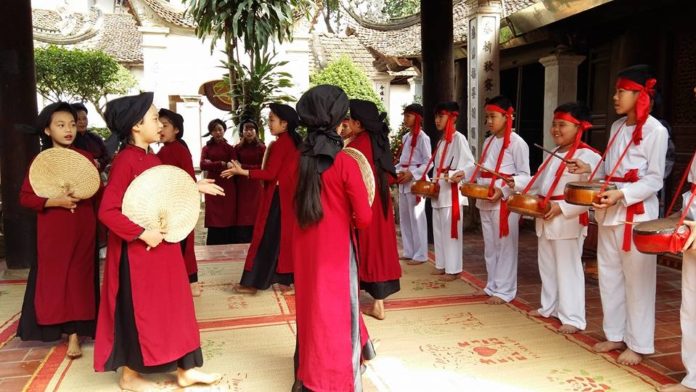Director of Hung Kings Museum Nguyen Anh Tuan said that the project on digitalising and documenting Xoan singing has succeeded in comprehensively and completely collecting and producing statistics on the documents and objects related to the traditional art form, which have been kept by achieves centres and researchers. The digitalisation process has also helped to preserve and promote the heritage’s cultural value.
In the three years since it was launched, the project has completed digitalising and uploading documents on Xoan singing, which can be found at http://baotanghungvuong.vn/hatxoan. The site’s content is divided into documentary photos, videos, objects, documents, and research, which are presented with detailed information with regards to location, cultural space, participating artisans, history and customs.
The project has collected five lyrics of Xoan singing in Han (Chinese script) and Nom (Vietnamese ideographic script); 30 CDs and records and 200 documentary photos of Xoan singing performances in Hanoi during the 1970s, among other significant documents.
Documents uploaded also include objects and artefacts related to the practice of Xoan singing, which belong to the families of artisans from the four original Xoan troupes from Kim Duc and Phuong Lau communes, Viet Tri city; 23 Xoan singing and folk singing clubs in Phu Tho province, and veteran folklore cultural researchers.
Nguyen Mai Thoa, Deputy Director of Hung Kings Museum shared that the project faced a number of difficulties during its implementation. It requires a lot time and effort for the documentary teams to collect the documents on Xoan singing as they were scattered everywhere, coming from both domestic and foreign achieve centres, publishing houses, research institutes, libraries and localities.
The project also faced financial obstacles as some of the agencies and units involved required high expenditure to buy their documents, she revealed. Another challenge the project faced was that veteran Xoan artisans are getting older, which also poses a risk of lacking human resources for preserving and passing on the ancestors’ treasure to younger generations.
In the time ahead, the project team will continue to collect more documents on Xoan singing by filming, recording, conducting interviews, taking notes, and systemising the documents.
The team also plans on carrying out a number of surveys on veteran Xoan artisans and communities, where Xoan singing is practiced regularly, and make copies of the documents and research on the art forms, which are currently kept at the Vietnam Musicological Institute and the databank at Hung Kings historical site.
Xoan singing, a vocal art of villages in the ancestral land of Phu Tho, dates back to the era of the Hung Kings. It is also known as Xuan (Spring) singing because it is usually performed in the springtime as people pray for peace, bumper crops, and favourable weather, and to show gratitude to the Hung Kings.
There are two forms of Xoan singing, ceremonial singing and festive singing. Xoan singing is not only singing and dancing, it is also the art of performance. Xoan artists must master the skills of singing, dancing and acting.




